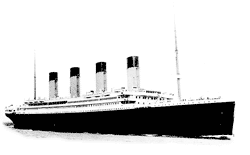Small Home Gazette, Spring 2012
Letter From the Editor: bungalows are survivors
For 100 years the Titanic has rested beneath the waves it was intended to float upon. As recounted in numerous movies, books, exhibits, plays and television shows, the story of the ship, its crew and passengers is an enduring morality tale of what can happen when something is considered indestructible.
 With the centennial of the April 15 Titanic disaster just past, I was thinking about the people who claimed a ticket in steerage. Many sought a better life in the U.S., and some of the survivors found it in a home of their own—possibly a bungalow.
With the centennial of the April 15 Titanic disaster just past, I was thinking about the people who claimed a ticket in steerage. Many sought a better life in the U.S., and some of the survivors found it in a home of their own—possibly a bungalow.
If you live in a bungalow, your home has survived much longer than the ill-fated Titanic. But is there an “iceberg” headed toward your home? What will happen to our bungalow neighborhoods in the next 10 years?
Nothing preserves history like an economic downturn, since few individuals have money to make changes. Our bungalows have survived the Great Depression and the Great Recession. Some have the integrity of their Arts & Crafts design intact, but many have been transformed. In our future economic recovery, will the teardowns or the aluminum and vinyl siding of the ‘90s and early 2000s return? Is this the iceberg that claims your house or neighborhood?
Some say our interest in sustainable building proves we’ve learned that the greenest house is the one that’s been standing in our neighborhoods for decades. Will tomorrow’s decision makers understand this and view bungalows as worthy of preservation? Is this the iceberg headed toward your house or neighborhood?
As the economy recovers and more money flows into our pockets (I can dream!), will we have the craftspeople available to perform sensitive updates to our homes? The expert craftspeople I know—many of them advertise in this newsletter—are successful and busy. My sense is that they alone cannot handle the demand for Arts & Crafts expertise. Will the lack of professional, knowledgeable expertise be the iceberg that sinks your house or neighborhood?
Complacency is easy. We can believe our bungalows and neighborhoods are indestructible—that the icebergs described above will be easy to avoid. I think it’s better to be prepared.
Here is how I think we avoid the icebergs.
Fifteen years ago our re-discovery of the bungalow was new and gaining steam. The “inadequate” label Minneapolis city planners applied to bungalows was countered but not conquered. While smaller in number, today’s army of bungalow enthusiasts is better organized and better informed. Our knowledge can melt icebergs.
Our Internet-driven age is re-assembling society. Today it is possible to indulge our inner Arts & Crafts geek like never before and find others across town or around the country who feel similarly. Our connections can melt icebergs.
Whether you know it or not, each of you is a beacon on your block. Your house is a shining example! Some of you might go further and invite a new neighbor over to subtly extol the virtues of bungalow life. A few of you might volunteer for a community group to ensure your future neighborhood includes bungalows. Our actions will melt those nasty icebergs.
Knowledge, connections, and action—we have a great start. We need to do more. We will.











